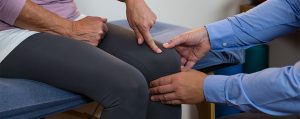Shoulder Instability and Athletes
Shoulder pain is the third most common pain complaint, following lower back and knee pain, with women being more likely to experience shoulder pain than men. Common causes of shoulder pain include tendon inflammation or tears, arthritis, fractures, and instability. Instability occurs when excessive shoulder mobility results in a lack of stability, often resulting in pain, popping sensation, feeling of the shoulder “giving out,” partial dislocations, weakness, and a “dead arm” feeling. Athletes who perform repeated overhead movements are at an increased risk of developing shoulder instability.
Pickleball Tips to Keep You Strong on The Court
Pickleball has recently taken the news by storm as one of the fastest-growing sports, which means it can lead to potential injury if you’re not proactive.
As a pro pickleball player and a physical therapist, I want to see you on the court, not in my clinic. Therefore, I will outline my favorite tips, which I use personally and with my patients to maintain strength and decrease the likelihood of injury. As an athlete, muscles are essential to perform; they support our joints to promote optimal function while minimizing stress. But you don’t have to be a pro athlete to reap the benefits of a fun and social sport like pickleball! Whether you’re a pickleball prodigy or simply enjoy a game or two on the weekends at your local court, here are three common pickleball injuries to be on the lookout for:
You Tore Your ACL, Now What?
You had the unimaginable happen; you tore your ACL. You probably felt it pop or knew exactly what happened when it happened. Your mind immediately started going 1000 miles per minute, thinking about the worst. “My season is over!” “Will I ever be able to play again?” “What happens next?” All these questions and more are likely swirling through your head, sending anxious thoughts through the roof. ACL tears are quite common in the sports injury world; anywhere from 100,000-200,000 people tear their ACL in a given year. While you may be worried now, this blog will outline steps to help inform your decisions moving forward and determine what will be best for your situation.
In-Season Arm Care Programs: Keeping Your Upper Body Healthy All Season Long
Keeping your arms and shoulders strong and mobile are important in a successful season for any overhead athlete. Often, skipping out on warming up, cooling down, and stretching can cause preventable injuries. Athletes can excel throughout their season without worrying about injury with proper care and effort. The throwing or hitting motion of sports such as baseball, softball, tennis, water polo, swimming, and volleyball could result in injury due to the tremendous force athletes put through their shoulders. In women’s volleyball, the ball can be spiked up to speeds of 70mph, and in tennis, players can serve up to 128 MPH. With such high velocity and force behind hitting and throwing, athletes need to keep up with strength and mobility. Here are six exercises all overhead athletes can do for a healthy upper body.
Tips for Tackling Golfer’s Elbow
As a physical therapist, I see many athletes who experience a golfer’s elbow, medically referred to as medial epicondylitis. This condition is characterized by a burning ache along the inside edge of the elbow, which worsens with gripping or during certain wrist motions. While it is a fairly common issue among athletes and recreational sports enthusiasts, it’s most commonly experienced by golfers.
Foot Injuries in Rhythmic Gymnasts
Rhythmic gymnastics is a sport in which gymnasts perform on a floor with an apparatus: either a hoop, ball, rope, ribbon, or club. The sport combines dance and gymnastics and requires strong, flexible, coordinated athletes. Due to the nature of the sport and the repetition during practice and performing, the most common area of injury for rhythmic gymnasts is the foot.
A Guide to a Bullet Proof Core for Overhead Athletes
While overhead sports rely heavily on our upper extremities (shoulders, elbows, and wrists), the core is often forgotten as a critical piece of the puzzle for success in sports with a high overhead demand. Many facets of the core contribute to overhead movements and strength. The core stabilizes the body from the legs up. Because the shoulder is a less stable joint by itself, maintaining a strong core is important for athletes such as pitchers and throwers.
Where Does Your Knee Hurt? What Your Pain Might Be Telling You
Knee pain is one of the most common diagnoses we treat at Athletico and is among the top three cases I see as an orthopedic physical therapist. According to the Journal of the American Medical Association, around 5% of doctor visits are for knee pain, and physical therapy is one of the primary treatment methods.
While knee pain, in general, is common, there are many different sources or causes of knee pain. In this article, we will explore how the location of your knee pain correlates with a possible injury and what physical therapy may entail for that injury.
